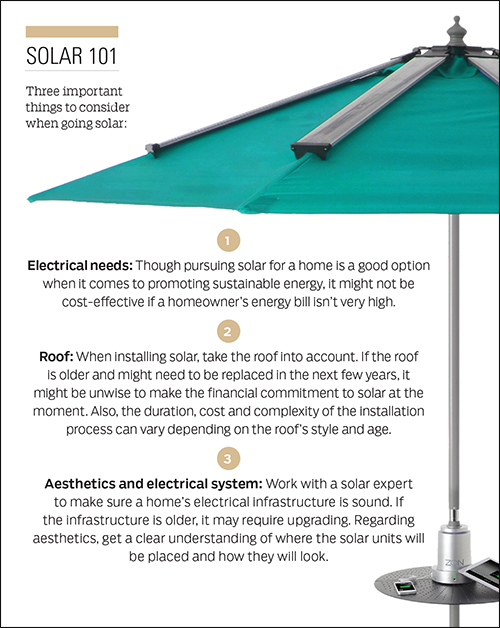
Pure Energy
Southern California residents are turning up the solar power and reaping the benefits.
-
CategoryUncategorized
-
Written byStefan Slater
Avo Babian says he has always been interested in technology and keenly aware of the energy crisis. So “going solar” with his 1940s, ranch-style home in Sherman Oaks seemed like a natural direction to move in. Once he started the process, Avo discovered his three-bedroom, two-bathroom, 1,750-square-foot house has ideal conditions for solar panels: a southern-facing roof and lots of sun.
He turned to the national company Real Goods (realgoods.com) for installation. The first set, installed in 2009, cost $20,000 for 2.4 KW. But with a 30% tax credit and a $9,000 rebate from the Los Angeles Department of Water and Power (LADWP), the final cost was less than $5,000.
Avo, who is a local orthodontist, had a second set of solar panels installed three years later to power his electric car. This time he spent $20,000 for 3.2 KW (costs per KW had gone down by then). With a 30% federal tax credit and a $7,000 rebate from LADWP, the final expense came to about $7,000.
“My electric bills were about $600 a year. Now I have no electric bills at all. I do drive an electric car, so depending on how much I drive, in the winter months I may have a bill. But the excess electricity made in the summer is stored as credits, which I can use to pay my bills in the winter,” he says.
The Net Energy Metering option (which Avo alluded to) allows residents to receive a credit for any surplus electricity that the solar system might supply back to the electric utility grid. This credit can then be applied to the resident’s electric bill to help with the costs that may occur for any energy that’s consumed (say, for instance, when the system isn’t operating because it’s nighttime or cloudy).
For Avo, solar was the right choice. “First, I save money on my bills so that I can repay my original buying cost in eight to 12 years. Second, I feel I am part of the solution.”

Jim and Lisa Schlager also have no regrets when it comes to installing a solar system on the roof of their home. “It’s one of the best investments that I’ve ever made,” says Jim, who works with Moss Adams, LLP.
Like Avo, Jim made the decision to purchase a solar system for his home (rather than leasing). “We have saltwater fish tanks, plus we have kids that seem to leave the lights on all the time,” says Jim. “Our electrical bill is probably higher than a lot of homes. Plus we have a flat roof, which is conducive to solar.
The total system cost of the Schlager’s project, installed by Los Angeles-based Xero Solar, was around $39,000, but the family qualified for a state rebate of $2,000 and was eligible for the 30% federal tax credit. Jim estimates he is saving roughly $400 a month on his electrical bill. “It’s an internal rate of return of over 20% with about a 5½-, six-year breakeven,” he says.
The Schlagers and Avo Babian are just two of a growing number of California households investing in solar. In 2013 state residents invested $7.1 billion to install solar systems for their homes, businesses and utility use, according to the Solar Energy Industries Association. That investment represents an 83% increase from 2012, and that overall growth is expected to continue.
Though photovoltaic (PV) technology has existed nationally since the 1950s, the technology itself has gradually improved over the last few decades—making the installation, cost and use of solar far simpler, more cost-effective and efficient. The Solar Energy Industries Association notes that national prices for the installation of residential and commercial PV systems have dropped 39% from 2010. Furthermore, solar has become especially relevant recently, as the state government continues to encourage the growth of clean, renewable energy.
Pleased so far, Jim notes there’s little maintenance, and because there are no moving parts, the system can last for years. He adds that he takes pride in knowing that he’s doing his part to help the environment by relying on clean, renewable energy.











